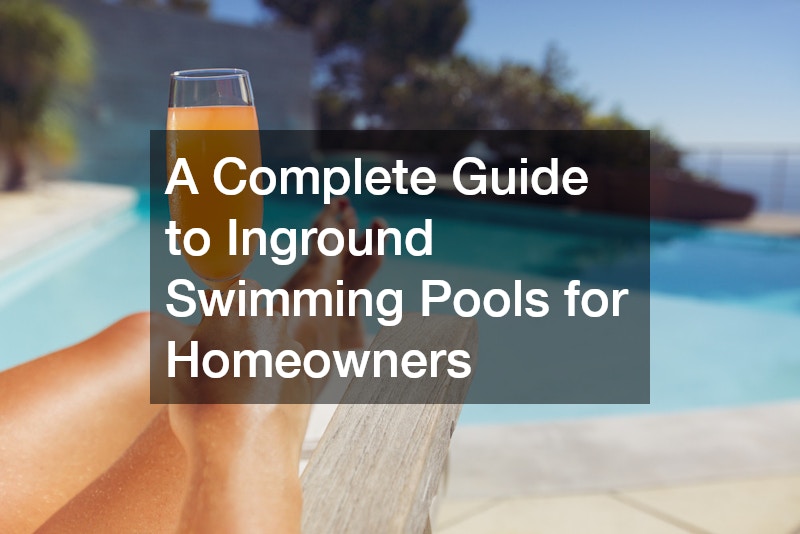Inground swimming pools are one of the most desirable additions to a backyard, offering relaxation, entertainment, and a touch of luxury. Whether you’re looking to enhance your outdoor space, improve your home’s appeal, or create a fun zone for family and friends, inground swimming pools provide a durable and stylish solution. This guide will walk you through the essentials of inground pools—from design and materials to maintenance and safety.
Understand the Types of Inground Swimming Pools
There are three main types of inground swimming pools: concrete, vinyl liner, and fiberglass. Each has distinct features that make them suitable for different needs and preferences.
-
Concrete Pools: Known for their durability and customization, concrete pools can be shaped and sized to fit any space. They allow for unique design features such as tanning ledges, waterfalls, and infinity edges. However, they often require more time to install and regular surface refinishing.
-
Vinyl Liner Pools: These pools use a custom-made vinyl sheet between the water and the pool structure. They’re popular for their smooth surface and design flexibility. Vinyl liner pools are typically easier and faster to install and offer a variety of liner patterns to choose from.
-
Fiberglass Pools: Manufactured as one-piece shells, fiberglass pools are pre-molded and delivered ready to install. They offer a smooth, non-porous surface that resists algae growth and requires less maintenance. While they come in limited shapes and sizes, installation is quick and hassle-free.
Choose the Right Location
Selecting the right spot for your inground swimming pool is crucial. Consider factors such as sun exposure, proximity to utilities, existing landscaping, and local zoning regulations. A flat area with plenty of sunlight is ideal, as it helps keep the water warmer and reduces the need for heating. You’ll also want to think about accessibility from your home, visibility for safety, and privacy from neighbors.
Explore Design Features and Enhancements
Modern inground swimming pools come with a wide range of design options and add-ons that can elevate both form and function. Some popular features include:
-
Waterfalls and Fountains: These create a peaceful ambiance and improve circulation.
-
Lighting: LED pool lights not only extend swimming hours but also enhance nighttime aesthetics.
-
Tanning Ledges: A shallow platform perfect for lounging or letting small children play safely.
-
Built-in Spas: Combine the luxury of a hot tub with your pool design for year-round enjoyment.
Decking materials like stamped concrete, pavers, or natural stone can complement your pool and enhance the surrounding landscape. Consider adding pergolas, outdoor kitchens, or lounge areas to create a full backyard retreat.
Understand Pool Filtration and Circulation Systems
An effective filtration and circulation system is vital for keeping your pool clean and safe. Inground swimming pools typically use one of three main types of filters: sand, cartridge, or diatomaceous earth (DE). Each system has pros and cons depending on maintenance preferences and performance needs.
Additionally, pumps and skimmers play an important role in circulating water and removing debris. Many homeowners are now choosing energy-efficient variable-speed pumps, which help conserve energy and maintain optimal water flow.
Focus on Safety
Safety is a top priority for any pool owner. Install barriers such as fences, safety covers, and alarms to prevent unsupervised access, especially for households with children or pets. Pool fencing should be at least four feet high with self-latching gates.
Other safety features to consider include:
-
Slip-resistant surfaces around the pool deck
-
Depth markers for swimmer awareness
-
Pool safety equipment like life rings and reaching poles
-
Clear signage if your pool has deep or sloped areas
Compliance with local building and safety codes is essential, so consult your municipality before installation.
Maintain Your Pool Regularly
Regular maintenance helps preserve water quality and prolongs the life of your inground swimming pool. Establish a routine that includes:
-
Skimming and vacuuming to remove debris
-
Testing and balancing water chemistry (pH, chlorine, alkalinity)
-
Brushing walls and tiles to prevent algae buildup
-
Cleaning filters based on manufacturer recommendations
-
Checking pump and circulation systems to ensure proper function
Automated systems, robotic pool cleaners, and smart pool monitoring tools can make maintenance easier and more efficient.
Plan for Seasonal Care
Depending on where you live, seasonal pool care may be necessary. In colder climates, closing the pool properly for winter is essential. This includes draining water to safe levels, adding winterizing chemicals, and covering the pool securely.
In warmer regions, year-round use may require more frequent attention to chemical balance and equipment inspections, especially during hot summer months when water usage increases.
Consider Long-Term Enjoyment
An inground swimming pool is a long-term investment in your lifestyle and home enjoyment. Whether you’re swimming laps, hosting pool parties, or simply floating under the sun, your pool should match your needs and aesthetics. Take time to plan every detail—design, location, features, and maintenance—and you’ll enjoy years of relaxation and recreation.
Inground swimming pools offer unmatched beauty, functionality, and fun for homeowners looking to upgrade their outdoor space. With thoughtful planning and consistent care, your pool can become the centerpiece of your backyard and a place where memories are made.




